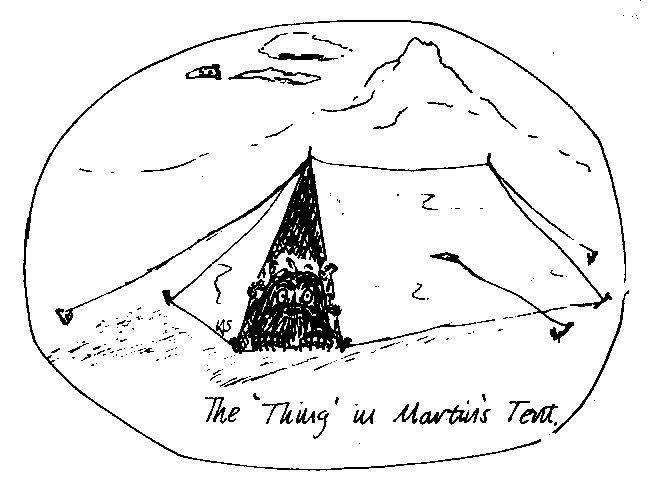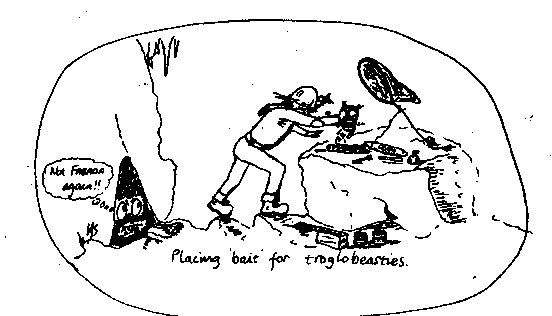
OUCC Proceedings 9 (1979)Biospeleological Collecting |
OUCC Proceedings 9 Index |
by Simon Fowler
The aim of this project was to make a zoological collection from the caves that we visited, with the long term hope that this would help future workers in more biologically significant fields. Small portable collecting kits in tobacco tins enabled collecting to be carried out at any site. However, attention was focused on two caves: Cueva del Osu near Los Lagos and Pozo de Fresno at El Mazuco in the Sierra de Cuera. Bait was left for several days in each and temperature readings were taken at convenient points about 50m from the entrances. The secondary nature of this project in the expedition programme led to its neglect as the demands of exploration increased with time, In particular, threshold zones were ignored and in the most potentially interesting cave (Pozu del Xitu), collecting was somewhat incidental.
Four tobacco tins containing:
7, 2"x½" plastic tubes, 6 filled with 70% ethanol. 1 brush. 1 pencil plus mounted needle. Jeye cloth. Greaseproof paper. (In future a very small pooter will be added)
One ammunition can including:
More tubes, some of them larger than those above. Max/Min thermometer. 2 large pooters. FAA (formalin, ethanol, and acetic acid) for fungal fruiting bodies and entomogenous fungi.
Thermometer:
Standard Max/Min are best.
 The
final material worth mentioning is the human element, keen expedition members are
essential. Fortunately for most of the time people could be persuaded to carry a tobacco
tin on their trips.
The
final material worth mentioning is the human element, keen expedition members are
essential. Fortunately for most of the time people could be persuaded to carry a tobacco
tin on their trips.
Bait should be left well covered so that any animals will not be disturbed by the approach of the biospeleologist! Clear labelling will aid relocation of the bait. On the last collecting trip all the remaining bait should be removed. Apart from this, collecting simply involves looking around carefully on mud slopes, in small pools, and other good beastie sites.
A considerable number of specimens were collected even at the relatively high altitude Cueva del Osu. These have yet to be identified to a detailed level. Prior to expedition there was certainly some doubt as to whether anything would be found. Not surprisingly cave fauna was much more abundant in Pozo de Fresno than in any of the other caves visited. The higher the temperature (12°C as opposed to 4°C) and the presumed higher organic input are probably responsible for this.
Temperature readings are best taken using a Max/Min thermometer. This should be well hidden, otherwise large fluctuations may be recorded due to inquisitive heavy-breathing cavers.
The experience gained from this year's collecting attempts will help with future expeditions e.g. chicken bait proved very successful in Fresno: after three days as many as three species were found on one bait. In contrast the crayfish bait in Osu attracted only a few diplurans. The position e.g. whether on dry, damp or wet mud, did not seem to be particularly important. All baits yielded the commonest species of beetle in numbers varying from 4 to 10. With the sudden appearance of a rich food source, this lack of habitat preference is not surprising.
With the experience gained in 1979 some standardization of baiting techniques will be attempted in Pozu del Xitu in 1980.
The specimens are being identified through Phil Chapman, who has spent three seasons collecting with Lancaster University Speleological Society at Tresviso, so at present only a rough idea of the groups collected can be given.
| Cueva del Osu Altitude 1230m 4.5 ± 0.5° C |
Arthropoda | Arachnida | Opiliones |
| Crustacea | Isopoda (Proaselius sp.) | ||
| Insecta | Collembola | ||
| Diplura | |||
| Coleoptera | |||
| Diplopoda | |||
| Chilopoda | (Complete dead remains) | ||
| Hoyo La Madre Altitude 880m |
Arthropoda | Arachnida | Opiliones |
| Insecta | Trichoptera | ||
| Diptera | |||
| Lepidoptera (Noctuidae and Geometridae) | |||
| Diplopoda | |||
| Mollusca | (Empty gastropod shells) | ||
| Pozu del Xitu Altitude 1680m |
Arthropoda | Insecta | Coleoptera (Carabidae) |
| Arachnida | Opiliones | ||
| Pozo de Fresno Altitude 355m 12° C |
Arthropoda | Insecta | Collembola |
| Thysanura | |||
| Coleoptera | |||
| Lepidoptera (Noctuidae) | |||
| Crustacea | Isopoda (inc. Proaselius sp.) | ||
| Annelida | Oligochaeta |